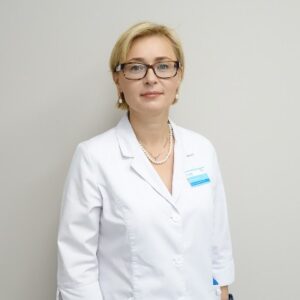What is PCOS Polycystic Ovarian Syndrome and how it impacts fertility?
Answer from: Halyna Strelko, MD
IVMED Fertility Center

PCOS is Polycystic Ovary Syndrome and the most important thing to remember is that it is a syndrome which means that there is not one symptom but several of them. The main point when we are talking about PCOS is first of all the specific appearance of the ovaries in an ultrasound scan – there should be visible a lot of follicles. The name “polycystic” doesn’t mean that there is a cyst but there are little follicles and they can grow, and produce eggs – there are absolutely normal follicles but because of the number of follicles, the term is “cysts” as in the past, most likely it was considered little cysts, not follicles because sometimes they are not growing well but finally that it is the mixed ideas. So, a lot of little follicles, diameter less than 10 milliliters, 15-20 of them in each ovary. In the past, it was considered to have 10 follicles to be classified as PCOS but now because of better resolution of ultrasound machines, officially it is classified as PCOS when there are 15-20, less than 10 millimeters in each ovary so, specific view in the ultrasound.
The second point is that in most cases there is an irregularity in the menstrual cycle – it means that the menstruation does not come every month but every 2- 3 months. It is because of irregular ovulation: follicles do not grow regularly, and sometimes do not grow for 2-3 months and as we know that menstruation is the sign of a working ovary: regular change of estrogen and progesterone and if we do not have the change, there is no menstruation. So, one of the signs of PCOS is menstrual irregularity.
Another sign is high androgen levels, high levels of “male hormone” in women, sometimes maybe too many hormones which normally can be detected in the male body. If we have a lot of androgens, it affects metabolism and it is causing insulin resistance and specific body composition. Approximately 50% of all the women with PCOS syndrome have the increased Body Mass Index and due to high androgen level and insulin resistance, the fat tissue is not located in normal places like hips but stay mostly in the abdominal – this is also very specific for PCOS – a male type of obesity. Those are probably the four main signs of the syndrome.
Answer from: Kate Davies, RN, BSc (Hons), FP Cert

PCOS is Polycystic Ovarian Syndrome and it’s a complex condition which is a hormonal condition but is also often accompanied by the presence of cysts on the ovaries. Both the hormones and the cysts can impact your ability to conceive, by causing a hormone imbalance but also, by having multiple cysts which could then prevent or make it more difficult to ovulate each cycle.
Answer from: Moses Batwala
Sims IVF

Polycystic Ovarian Syndrome or PCOS as it’s commonly known is a both a metabolic and hormonal disorder which is common in women of reproductive age and when I say reproductive age that’s women anywhere between the ages of 18 to 45 and we know that Polycystic Ovarian Syndrome affects about 5% of women in the general population and it is as I mentioned, it’s both a metabolic and hormonal disorder but its genesis is really in the metabolic nature and there are some women who are genetically predisposed to having their cells resistant to absorption of glucose from their circulation and because of this genetic resistance to absorption of glucose, their bodies react by increasing their insulin levels. However, because the insulin levels in these women rise, through a series of other interactions, it causes a fall in something called sex hormone binding globulin and therefore, the androgen levels (androgen are male type hormones they’re both in men and in women but in women they’re normally in low levels) however, because of this chain of reactions whereby the insulin goes up, the sex hormone binding globulin goes down, androgen levels in the women rise and this is not a good thing in women because once the androgen levels start to rise, they affect the functioning of the ovaries and they cause the ovaries to not ovulate as normal and because women stop ovulating, they get irregular periods and sometimes even in quite severe cases they stop ovulating, they stop having periods altogether and they have what we call amenorrhea (no periods) at all but that is at the more severe scale but most times women have irregular periods where they will have maybe instead of having 12 periods in the year, they’ll have maybe three or four periods the entire year. They have unpredictable periods and it’s because they’re not ovulating that’s why they have difficulty becoming pregnant and we classify this as an-ovulatory infertility where a woman is not releasing an egg and that is the reason why she does not become pregnant.
Answer from: Radwan Faraj, MD

polycystic ovarian syndrome. And this is an imbalance in the hormones due to a condition we call insulin resistance, and that will lead to irregular ovulation occasionally some facial hair. The other possible causes are drugs if you use any or have any medical condition, and occasionally a very rare condition which we call ovarian insufficiency, in which the ovary will become really unable to produce the hormones and ovulate from an early age.
What is the medical definition of PCOS and how common the PCOS is within infertile patients?
ne of the most common causes of infertility in women is PCOS. The hormonal imbalance affects ovulation and because of lack or only occasional release of egg, there is little to no chance for pregnancy.
Related questions
What happens if you ovulate before IVF?

What are the side effects of ovulation induction?








